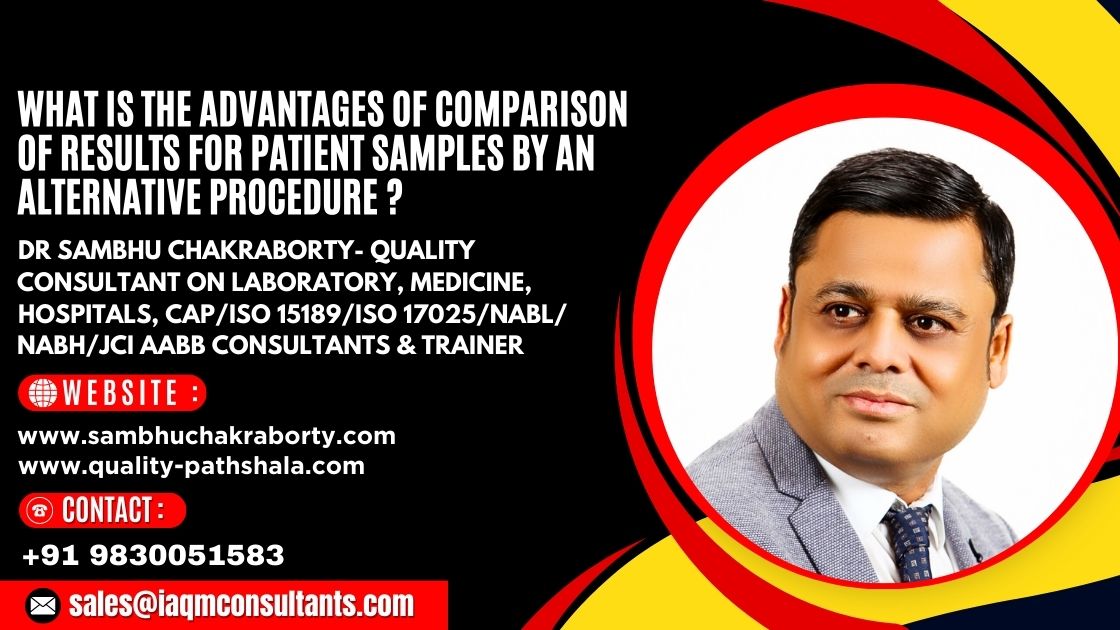Comparing results for patient samples on a specified schedule to results obtained from an alternative procedure validated against a reference method is a quality control practice used to ensure the accuracy and reliability of the testing process. This approach involves running patient samples on both the standard procedure (routine method) and an alternative procedure (often a gold standard or reference method) to identify any discrepancies or potential issues. Here are the advantages of this practice, along with an example
Advantages:
- Accuracy Verification: Comparing results from the routine method with those obtained from an alternative validated method allows the laboratory to verify the accuracy of the routine procedure. If the routine method consistently deviates from the validated alternative method, it could signal potential inaccuracies that need to be addressed.
- Bias Detection: Identifying systematic differences or biases between the routine method and the alternative method is crucial. It helps ensure that the routine method is not consistently overestimating or underestimating the true values.
- Method Performance Monitoring: This practice allows ongoing monitoring of the performance of the routine method. Any shifts in method performance can be detected, and corrective actions can be taken to maintain accuracy.
- Quality Improvement: If discrepancies between the routine method and the alternative method are identified, it prompts the laboratory to investigate the root cause and make necessary adjustments to improve method accuracy.
- Patient Safety: Ensuring accurate and consistent test results directly contributes to patient safety by preventing misdiagnosis and inappropriate treatment decisions.
- Data Integrity: Regularly comparing results from different methods enhances the integrity of the laboratory’s data, as any inconsistencies can be promptly addressed.
Example: Blood Glucose Testing
Let’s say a medical laboratory performs blood glucose testing using both its routine glucose analyzer and a well-established, validated alternative method (e.g., a reference laboratory’s analyzer).
Scenario:
The laboratory’s routine glucose analyzer is known to provide rapid results but has been associated with occasional deviations.
The reference laboratory’s analyzer is considered a gold standard, providing highly accurate results but with a longer turnaround time.
Advantages in this context:
- Accuracy Verification: By periodically running the same set of patient samples on both analyzers, the laboratory can compare the results. If there’s a consistent difference between the routine analyzer and the reference analyzer, it indicates the need to investigate potential issues with the routine metho
- Bias Detection: If the routine analyzer consistently shows higher blood glucose values compared to the reference analyzer, it could suggest a positive bias in the routine method. This insight prompts further investigation and possible calibration adjustments.
- Method Performance Monitoring: Over time, if the routine analyzer’s results drift away from the reference analyzer’s results, it highlights the need for recalibration or maintenance to bring the routine method back in line with accurate results.
- Quality Improvement: Discovering discrepancies between the routine and reference methods prompts the laboratory to take corrective actions. This could involve recalibration, retraining of personnel, or addressing any other factors contributing to the bias.
In summary, comparing patient sample results between the routine method and a validated alternative method serves as a powerful quality control practice to identify discrepancies, biases, and shifts in method performance. It helps laboratories maintain accurate and reliable testing procedures, ultimately contributing to patient care and safety.
About the author
Dr. Sambhu Chakraborty is a distinguished consultant in quality accreditation for laboratories and hospitals. With a leadership portfolio that includes directorial roles in two laboratory organizations and a consulting firm, as well as chairmanship in a prominent laboratory organization, Dr. Chakraborty is a respected voice in the field. For further engagement or inquiries, Dr. Chakraborty can be contacted through email at director@iaqmconsultants.com and info@sambhuchakraborty.com. Additional resourcesand contact information are available on his websites, https://www.quality-pathshala.com and https://www.sambhuchakraborty.com, or via WhatsApp at +919830051583

Great blog!
How this concept is useful in Haematology Lab?
Thanks
Very great article, would you consider providing step by step involved in the calculations of the comparison and examples which defines acceptable or rejected comparison.